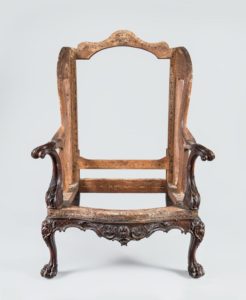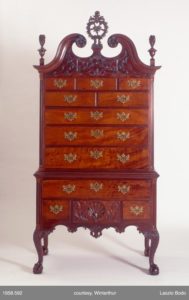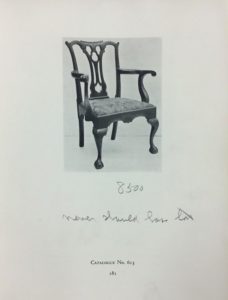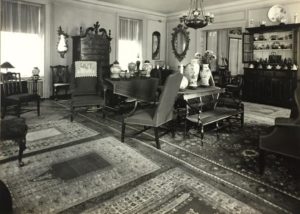Buying and Selling Philadelphia: The Story of the Legendary 1929 Reifsnyder Sale
Emelie Gevalt,
Andrew W. Mellon Foundation Curatorial Track PhD Fellow,
Art History, University of Delaware
In the spring of 1929, just months before the stock market crash that would plunge the country into the Great Depression, the American antiques market surged to an astonishing peak with the sale of the Howard Reifsnyder collection. Comprising an unusually fine group of Philadelphia furniture and other decorative arts, including top lots destined for the collections of Winterthur and the Philadelphia Museum of Art (Figures 1 and 4), the auction became an instant legend, realizing a then-staggering total of almost $600,000 and establishing a long legacy of prestige for objects with Reifsnyder provenance.
The foundation of the sale’s success was laid many years earlier with Reifsnyder’s careful approach to showcasing his collection. A meticulous and scrupulously well-mannered merchant from Philadelphia, the collector appears to have been a private man. He was willing to provide access to his holdings, however, when an opportunity to enhance his cachet was available. Generous loans to the burgeoning Pennsylvania Museum (the precursor to the Philadelphia Museum of Art) and selected inclusions in publications such as William Hornor’s Blue Book of Philadelphia Furniture would help develop the collection’s reputation for excellence. In 1926, a visit to Reifsnyder’s Walnut Street residence made a striking impression on members of the Walpole Society, who reported, “practically everything he has is of museum quality,” and “one was almost oppressed by the beauty of the furniture.”1 (Figure 2)
This publicity stimulated a high regard for Reifnsyder’s collection long before the material came to market, especially within the networks of top collectors. Possibly adding to a sense of anticipation, American Art Galleries, the New York-based firm that would eventually host the auction, had courted Reifsnyder for some time.2 No doubt spurred on by American Art Galleries, the press further encouraged interest in the auction. The Magazine Antiques urged that “everyone who can should see this great collection,” positioning the pre-sale exhibition as a cultural opportunity, not just a consumerist one, and suggesting the high levels of popularity commanded by antiques at the time of the sale. The article asserted that the collection also contained sufficient variety that “the small buyer may feel confident that he will have his chance among the giants,” a comment that speaks to the aspirational appeal of the Colonial Revival aesthetic.3
By the time of the sales, well-known collectors from Francis P. Garvan to William Randolph Hearst were primed to participate enthusiastically. Even after a bidding war with Hearst drove Henry Francis du Pont to spend a record-breaking $44,000 on the sale’s top lot, he showed no buyer’s remorse. In all, du Pont arranged at least one additional purchase after the sale for his burgeoning collection at Winterthur. Noting in his catalogue that he “never should have lost” lot 613 (Figure 3), du Pont paid an extra $2,000 above the $8,500 hammer price to acquire the James Gillingham armchair from the successful bidder, Colonial Revival furniture manufacturer Erskine-Danforth.4 Other active purchasers included the Philadelphia dealer Thomas Curran, who won lot 674, an easy chair attributed to Benjamin Randolph, on behalf of the Philadelphia Museum of Art for a stunning $33,000 (Figure 4). Israel Sack was also an active purchaser, having reportedly secured a significant line of credit from the auction house in advance of the sale.5
Although the high quality of the Reifsnyder collection played a primary role in the sale’s extraordinary success, a full exploration of the auction’s history and impact requires that we look beyond the beauty of individual lots towards a complex convergence of social factors. The long-cultivated mystique around the collection, a marketing campaign that excited popular interest, and a powerful competitive dynamic among top buyers gave shape to this watershed moment in the history of American antiques. Even at a distance of almost 90 years, the Reifsnyder sale tells an important story of not only why but also how we infuse antiques with value.
N.B. Thanks to the support of the Decorative Arts Trust, research on this topic was recently presented at the Philadelphia Antiques and Art Show. The author welcomes correspondence on objects with Reifsnyder provenance as part of ongoing work on the project.
1
Elizabeth Stillinger, The Antiquers (New York: Alfred A. Knopf, 1980), 202, citing the Walpole Society Notebook for 1926.
2
Arrangements did not come to fruition until after the collector’s death early in 1929. Wesley Towner, The Elegant Auctioneers (London: Victor Gollancz, Ltd., 1971), 451.
3
Bondome [Homer Eaton Keyes], “Shop Talk,” The Magazine Antiques 15 (April 1929), 309.
4
Henry Francis du Pont, Letter to Otto Bernet, April 29, 1929; Otto Bernet, Letter to Henry Francis du Point, May 10, 1929. Archives, Winterthur Library.
5
Albert Sack, interview by Brock Jobe, November 7, 2002, transcript, 28. Winterthur Oral History Collection, Arc. 36, Downs Collection, Winterthur Library.
Emelie Gevalt,
Andrew W. Mellon Foundation Curatorial Track PhD Fellow,
Art History, University of Delaware
In the spring of 1929, just months before the stock market crash that would plunge the country into the Great Depression, the American antiques market surged to an astonishing peak with the sale of the Howard Reifsnyder collection. Comprising an unusually fine group of Philadelphia furniture and other decorative arts, including top lots destined for the collections of Winterthur and the Philadelphia Museum of Art (Figures 1 and 4), the auction became an instant legend, realizing a then-staggering total of almost $600,000 and establishing a long legacy of prestige for objects with Reifsnyder provenance.
The foundation of the sale’s success was laid many years earlier with Reifsnyder’s careful approach to showcasing his collection. A meticulous and scrupulously well-mannered merchant from Philadelphia, the collector appears to have been a private man. He was willing to provide access to his holdings, however, when an opportunity to enhance his cachet was available. Generous loans to the burgeoning Pennsylvania Museum (the precursor to the Philadelphia Museum of Art) and selected inclusions in publications such as William Hornor’s Blue Book of Philadelphia Furniture would help develop the collection’s reputation for excellence. In 1926, a visit to Reifsnyder’s Walnut Street residence made a striking impression on members of the Walpole Society, who reported, “practically everything he has is of museum quality,” and “one was almost oppressed by the beauty of the furniture.”1 (Figure 2)
This publicity stimulated a high regard for Reifnsyder’s collection long before the material came to market, especially within the networks of top collectors. Possibly adding to a sense of anticipation, American Art Galleries, the New York-based firm that would eventually host the auction, had courted Reifsnyder for some time.2 No doubt spurred on by American Art Galleries, the press further encouraged interest in the auction. The Magazine Antiques urged that “everyone who can should see this great collection,” positioning the pre-sale exhibition as a cultural opportunity, not just a consumerist one, and suggesting the high levels of popularity commanded by antiques at the time of the sale. The article asserted that the collection also contained sufficient variety that “the small buyer may feel confident that he will have his chance among the giants,” a comment that speaks to the aspirational appeal of the Colonial Revival aesthetic.3
By the time of the sales, well-known collectors from Francis P. Garvan to William Randolph Hearst were primed to participate enthusiastically. Even after a bidding war with Hearst drove Henry Francis du Pont to spend a record-breaking $44,000 on the sale’s top lot, he showed no buyer’s remorse. In all, du Pont arranged at least one additional purchase after the sale for his burgeoning collection at Winterthur. Noting in his catalogue that he “never should have lost” lot 613 (Figure 3), du Pont paid an extra $2,000 above the $8,500 hammer price to acquire the James Gillingham armchair from the successful bidder, Colonial Revival furniture manufacturer Erskine-Danforth.4 Other active purchasers included the Philadelphia dealer Thomas Curran, who won lot 674, an easy chair attributed to Benjamin Randolph, on behalf of the Philadelphia Museum of Art for a stunning $33,000 (Figure 4). Israel Sack was also an active purchaser, having reportedly secured a significant line of credit from the auction house in advance of the sale.5
Although the high quality of the Reifsnyder collection played a primary role in the sale’s extraordinary success, a full exploration of the auction’s history and impact requires that we look beyond the beauty of individual lots towards a complex convergence of social factors. The long-cultivated mystique around the collection, a marketing campaign that excited popular interest, and a powerful competitive dynamic among top buyers gave shape to this watershed moment in the history of American antiques. Even at a distance of almost 90 years, the Reifsnyder sale tells an important story of not only why but also how we infuse antiques with value.
N.B. Thanks to the support of the Decorative Arts Trust, research on this topic was recently presented at the Philadelphia Antiques and Art Show. The author welcomes correspondence on objects with Reifsnyder provenance as part of ongoing work on the project.
1
Elizabeth Stillinger, The Antiquers (New York: Alfred A. Knopf, 1980), 202, citing the Walpole Society Notebook for 1926.
2
Arrangements did not come to fruition until after the collector’s death early in 1929. Wesley Towner, The Elegant Auctioneers (London: Victor Gollancz, Ltd., 1971), 451.
3
Bondome [Homer Eaton Keyes], “Shop Talk,” The Magazine Antiques 15 (April 1929), 309.
4
Henry Francis du Pont, Letter to Otto Bernet, April 29, 1929; Otto Bernet, Letter to Henry Francis du Point, May 10, 1929. Archives, Winterthur Library.
5
Albert Sack, interview by Brock Jobe, November 7, 2002, transcript, 28. Winterthur Oral History Collection, Arc. 36, Downs Collection, Winterthur Library.




